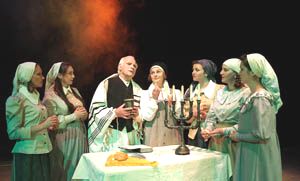Multiple reality of Bruno Schulz
In Drohobych traveled in time along the rout laid by outstanding master
Name of the Polish-Jewish-Ukrainian writer and artist Bruno Schulz is yet not well known by the public. Schulz was born in Drohobych in 1892, when this territory was still a part of the Austro-Hungarian Empire. Only the professionals in the sphere of art are familiar with his graphics and extremely original literature, which, by the way, was translated into almost all world’s languages. The so-called Schulz Boom began nearly 10 years ago, when a sensational discovery was made: archeologists found paintings in the Landau’s home – murals created by Schulz right before his death in 1942. According to the experts, the mural paintings are the illustrations of the fairy tales by Brothers Grimm. Some of the murals discovered and restored by Polish specialists were illegally transported to the Israeli Museum Yad Vashem and only five remaining fragments after restoration were transported to the Museum of Drohobych Region in the Palace of Arts.
Around that time Ihor Menko Polish Scientific and Information Center at Ivan Franko Drohobych Pedagogical University together with Polish colleagues from the Society “Bruno Schulz Festival” in Lublin (director Grzegorz Jozefczuk) got the idea of creating the festival dedicated to the creative work of Bruno Schulz. International Festival “Imagination Arch of Bruno Schulz” (director Vira Meniok) was organized and held in the city where he was born and died. Scene of yet another organizer – Yurii Drohobych Lviv Oblast Music and Drama Theater (director Mykola Hnatenko) became the venue for the artistic events of the festival.
Schulz idealized his hometown, in his writings Drohobych turned into a myth. It was an intersection of worlds and spaces, here the characters of his novels were looking for each other on the verge of a dream, the reality multiplied here and, according to the author’s plan, it was impossible to grasp because, as he claimed, new different world will appear after the visible world is gone.
Creative work of Schulz, who was a follower of the theory of three worlds unity: parallel existence of present, past, and future. He gave his characters the ease of crossing the boundaries of time, which, without any doubt, was a unique literary phenomenon that over the years has gained a deeper level of comprehension. Despite the fact that his writing was focused on the coloring of the small Galician town, Schulz’s fantasy and imagination expand the horizons of the city and reach amazing universal generalizations.
The week of the “Imagination Arch of Bruno Schulz” was full of cultural events. Reputable scientific conference “Bruno Schulz – Philosopher and Literary Theorist” brought together renowned experts from around the world. Schulz was presented in the field of fine arts from different aspects. In addition to the unique exhibition “Horizons of Time” that opened in Lviv National Art Gallery and features original paintings and graphics by Schulz from the funds of the Adam Mickiewicz Warsaw Museum of Literature, many private views, performances, multimedia projects, installations, photo exhibitions and exhibition of paintings, graphics, and watercolors also took place during this week.
There was also held the screening of the award-winning film Sanatorium Under the Sign of the Hourglass (1973) directed by Polish film director Wojciech Has based on the novel by Schulz. The film was restored with the use of digital technologies and for the first time it was screened with Ukrainian subtitles.
Translators presented their translations of Schulz’s works in English, German, Chinese, Portuguese, Spanish, English, Hungarian, and Romanian. Yurii Andrukhovych presented the most recent Ukrainian translation of “Cinnamon Shops and All Other Stories.”
The theater part of the festival was also exciting. Leszek Mondzik and “Plastic Scene” Theater from Lublin presented their performance action Halls of Bruno Schulz Memory. Drohobych Student Theater “Alter” made a theatrical and literary mythical journey around Drohobych in their performance Zodiac of the City or Stories of a Spring. Pinokio Theater from Lodz presented the play Bruno Schulz – Story of Criminal Imagination directed by Conrad Dvorakovsky. The host of the festival – Yurii Drohobych Theater presented the play Tevye Tevel by Sholem Aleichem, author just as much significant for the world’s and Jewish culture.
In the epilogue to his translation Andrukhovych wrote: “Before I ever read a line of his writing I already made him one of my favorite writers.” Paradoxically, but the same happened to many people, who after the first impression immerse themselves into fantastic and at the same time very realistic world of Bruno Schulz. The International Festival “Imagination Arch of Bruno Schulz” makes this possible by spreading the information about the artist in Drohobych and all around the world. These efforts will ensure that there will be no cases like the one which was mentioned by one of the participants of the festival, when he spent an hour looking for the monument to Erasmus of Rotterdam in Rotterdam and none of the residents could help him. I am convinced that Schulz Fest will encourage residents of Drohobych to read the works of Schulz and with a special feeling will be passing the street of the city with the memorial plaque with the inscription: “In this place the great artist and resident of Drohobych Bruno Schulz was shot by the Gestapo officer.”






